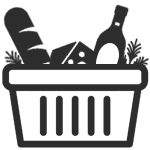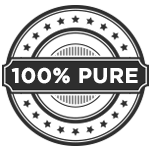Pepper-and-Herb-Crusted Filet Recipe, Spotlight on Condimento Barili Exclusivi, Grinding Peppercorns, You can Be Too Thin, and Everyday Habits That May Shield You from Dementia
The holiday season is almost upon us, so I’m delighted to share my recipe for a fabulous beef tenderloin, guaranteed to wow you and your guests. It’s also a good time for a reminder on the importance of healthy habits, some of which get shelved for the next two months as parties and dinners take precedence. Maintaining good-for-you strategies isn’t as hard as you might think and, as you’ll read in the Fitness Flash below, they can be transformative.
Pepper-and-Herb-Crusted Filet
 Pepper-and-Herb-Crusted Filet
Pepper-and-Herb-Crusted FiletBalsamic vinegar enhances this most tender cut of beef and adds richness to the pan juices.
Ingredients
- 8 garlic cloves, peeled
- 2 tablespoons coarse sea salt
- 1/3 cup extra virgin olive oil, plus 2 tablespoons for searing
- 1 tablespoon Condimento Barili Exclusivi, plus more for drizzling
- 1 tablespoon fresh coarsely cracked black pepper
- 2 tablespoons fresh thyme leaves
- 1/4 cup fresh rosemary needles from a 3- or 4-inch sprig
- 2 tablespoons grainy mustard
- One 3-pound center-cut beef tenderloin, trimmed as needed
Directions
Step 1
Preheat your oven to 450ºF. In a small food processor, process the garlic and salt until the garlic is finely chopped. Add the 1/3 cup olive oil, vinegar, black pepper, thyme, and rosemary, and process until the herbs are evenly chopped. Stir in the mustard and set aside.
Step 2
Heat a large cast-iron skillet or Dutch oven over medium-high heat. When hot, add the 2 tablespoons olive oil and then the beef, searing it on all sides until nicely browned, 3 to 4 minutes per side, making quarter turns with tongs. Transfer the meat to a cutting board and let cool slightly.
Step 3
Coat the tenderloin evenly on all sides with the reserved herb mixture, and then transfer it to a meat rack set in a roasting pan. Roast it until the internal temperature reaches your desired doneness on an instant-read thermometer, about 20 to 30 minutes for medium-rare (depending on its thickness). Let it rest for at least 10 minutes to seal in the juices before you carve it into thick slices. Serve with a drizzle of pan juices and a few drops of vinegar.
Yields 8 servings

Healthy Ingredient Spotlight
Condimento Barili Exclusivi
With so many bottles on supermarket and gourmet shop shelves labeled “balsamic,” it’s important to know that true balsamic vinegar can only come from Modena, Italy. The highest designation is Aceto Balsamico Tradizionale DOP (Denominazione di Origine Protetta,or Protected Origin Denomination), which is crafted exclusively from cooked grape must, the result of cooking down all parts of the grapes. This kind of vinegar is aged for a minimum of 12 years, and a few ounces cost well over a hundred dollars, so it’s not used for cooking or making vinaigrettes but for drizzling sparingly as a finishing touch.
Aceto Balsamico di Modena IGP (Indicazione Geografica Protetta, or Protected Geographical Indication) is made from grape must and wine vinegar and aged in wooden barrels for at least two months. It gets sweeter and more harmonious as it achieves the perfect ratio of density to acidity.
Since I first introduced the T. J. Robinson Curated Culinary Selections, I’ve always included a very special balsamic, Condimento all’Aceto Balsamico di Modena IGP Barili Exclusivi—meaning “from exclusive barrels.” The condimento designation allows vinegar vintners to go beyond the strict requirements set by the consortiums in Modena, whose job it is to make sure their rules are adhered to. This year’s is our richest yet. The barrels used during the aging process impart complex flavors and a richer texture through contact with the wood. The result is a truly unique balsamic full of character. I love it in marinades and sauces and as a drizzle on finished dishes.

Quick Kitchen Nugget
Grinding Peppercorns
Ground black pepper starts to lose its flavor within a matter of days, so the taste of packaged ground pepper, which has likely been sitting around for months, is going to be disappointing. That’s why I prefer buying whole black peppercorns. The question then becomes whether to use a pepper mill to grind it as you need it or run small amounts through a bean or spice grinder and transfer it to a shaker jar.
The answer depends on how fast you’ll use it. If you cook every day, you’re likely to go through the jar in short order, and this approach can be a time and labor saver. I also like to have a dedicated grinder for pepper so I don’t run the risk of transferring flavors, which can happen if you use the same grinder for coffee or a strong spice like cumin. (Most grinders can be washed, but follow manufacturer directions carefully.) On the other hand, if you mostly use black pepper to season cooked food, use a pepper mill at the table. The classic hourglass-shaped mill works well for many people, but if you have hand arthritis or any other limitations, consider getting an electric one that requires less effort.

For Your Best Health
You can Be Too Thin
Legend has it that Wallis Simpson, the former Duchess of Windsor, famously said you can never be too rich or too thin. As it turns out, at least half that statement may be false. New research presented at the annual meeting of the European Association for the Study of Diabetes in Vienna, Austria, challenges long-held assumptions about body weight and health.
“Both underweight and obesity are major global health challenges,” says Sigrid Bjerge Gribsholt, MD, PhD, of the Steno Diabetes Center Aarhus at Aarhus University Hospital in Aarhus, Denmark, who led the research. “Obesity may disrupt the body’s metabolism, weaken the immune system, and lead to diseases like type 2 diabetes, cardiovascular diseases, and up to 15 different cancers, while underweight is tied to malnutrition, weakened immunity, and nutrient deficiencies. There are conflicting findings about the BMI range linked to lowest mortality. It was once thought to be 20 to 25, but it may be shifting upward over time owing to medical advances and improvements in general health.”
To provide some clarity, Dr. Gribsholt, Professor Jens Meldgaard Bruun, MD, also of the Steno Diabetes Center Aarhus, and colleagues used health data to examine the relationship between BMI and mortality in 85,761 individuals (81.4% female, median age at baseline 66.4 years). About 8% of the participants died during the 5-year follow-up period.
Their analysis found that people in the underweight category were almost three times more likely (2.73 times) to have died than those with a BMI toward the top of the healthy range (22.5 to <25.0 kg/m2, the reference population). People with BMI of 40 kg/m2 and above (categorized as severe obesity) were more than twice as likely (2.1 times) to have died compared with the reference population.
However, higher mortality rates were also found for some BMIs that are considered healthy. People with a BMI of 18.5 to <20.0 kg/m2, at the lower end of the healthy weight range, were twice as likely to have died as those in the reference population. Similarly, those with a 20.0 to <22.5 kg/m2, in the middle of the healthy weight range, were 27% more likely to have died than the reference population.
By contrast, individuals with a BMI in the overweight range (25 to <30 kg/m2) and those with a BMI at the lower part of the obese range (30.0 to <35.0 kg/m2) were no more likely to have died than those in the reference population, a phenomenon sometimes referred to as being metabolically healthy or “fat but fit.” Those with a BMI of 35 to <40.0 kg/m2 did have an increased risk of death of 23%.
Researchers saw a similar pattern when they looked at the relationship between BMI and obesity in participants of different ages, sexes, and levels of education, but they were surprised to find that BMI was not associated with a higher mortality—up to a BMI of 35 kg/m2—and that even a BMI 35 to <40 kg/m2 was only associated with a slightly increased risk.
“One possible reason for the results is reverse causation: Some people may lose weight because of an underlying illness,” said Dr. Gribsholt. “In those cases, it is the illness, not the low weight itself, that increases the risk of death, which can make it look like having a higher BMI is protective. Since our data came from people who were having scans for health reasons, we cannot completely rule this out. It is also possible that people with higher BMI who live longer—most of the people we studied were elderly—may have certain protective traits that influence the results. Still, in line with earlier research, we found that people who are in the underweight range face a much higher risk of death.”
“BMI isn’t the only indicator that someone is carrying unhealthy levels of fat,” Dr. Bruun pointed out. “Other important factors include how the fat is distributed. Visceral fat—fat that is very metabolically active and stored deep within the abdomen, wrapped around the organs—secretes compounds that adversely affect metabolic health. As a result, an individual who has a BMI of 35 and is apple-shaped—the excess fat is around their abdomen—may have type 2 diabetes or high blood pressure, while another individual with the same BMI may be free of these problems because the excess fat is on their hips, buttocks, and thighs. It is clear that the treatment of obesity should be personalized to take into account factors such as fat distribution and the presence of conditions such as type 2 diabetes when setting a target weight.”

Fitness Flash
Everyday Habits That May Shield You from Dementia
Alzheimer’s is on the rise, but evidence shows lifestyle interventions can significantly preserve memory and cognition. Prevention may hold the key to reducing the massive global burden of dementia, according to a commentary from researchers at Florida Atlantic University’s Charles E. Schmidt College of Medicine, published in The American Journal of Medicine.
An estimated 7.2 million Americans over age 65 currently live with Alzheimer’s disease. That number is expected to nearly double to 13.8 million by 2060. These increases reflect more than demographic shifts; they point to a growing public health crisis that requires a proactive new approach. While chronological age is the strongest known risk factor for cognitive decline, losing cognitive function is not an inevitable part of aging.
“While deaths from cardiovascular disease have declined since 2000, deaths from Alzheimer’s disease have surged by more than 140%,” said commentary coauthor Charles H. Hennekens, MD, the First Sir Richard Doll Professor of Medicine and Preventive Medicine and senior academic advisor at Schmidt. “At the same time, it is estimated that up to 45% of dementia risk could be attributed to modifiable lifestyle and environmental factors.”
Lifestyle risk factors like physical inactivity, poor diet, obesity, alcohol use, and conditions such as hypertension, diabetes, depression, and social or intellectual isolation are believed to contribute to cognitive decline. The authors point out that the same therapeutic lifestyle changes proven effective for reducing risks of cardiovascular and other major diseases may also help reduce cognitive decline, potentially with additive effects when multiple risk factors are present.
The commentary highlights the recently published results from POINTER, the first large-scale US-based randomized trial to test whether intensive lifestyle changes can improve cognitive outcomes in older adults at high risk of decline. In this trial, participants who were assigned at random to a structured, team-based lifestyle intervention showed statistically significant and clinically meaningful improvements in global cognition over two years. These gains were especially notable in executive functions such as memory, attention, planning, and decision-making. The intervention emphasized regular physical activity, a combination of Mediterranean and DASH-style diets, cognitive stimulation, and social engagement reinforced through ongoing professional guidance and group support.
These findings are similar to an earlier Finnish trial, the FINGER trial, in which participants with elevated cardiovascular risk scores assigned at random to a multidomain lifestyle approach experienced cognitive benefits. “The data from both these landmark large-scale randomized trials demonstrate that lifestyle changes—previously shown to reduce heart disease and cancer—also hold transformative potential for brain health,” Dr. Hennekens said.
The researchers also speculated about biological mechanisms that may underlie these benefits. Physical activity, for example, increases brain-derived neurotrophic factor, which supports hippocampal growth, while also improving blood flow and reducing inflammation. Healthy dietary patterns like the Mediterranean and DASH diets can lower oxidative stress and improve insulin sensitivity as well as risks of cardiovascular disease. Quitting smoking may help preserve brain structure and white matter integrity, and regular social and cognitive engagement promotes neuroplasticity and mental resilience.
“The implications for clinical practice, public health, and government policy are potentially enormous,” said Parvathi Perumareddi, DO, coauthor and an associate professor of family medicine at Schmidt. “Clinicians now have powerful evidence-based tools to help their patients prevent or slow cognitive decline, tools that go beyond medications, are generally low-risk, and are cost-effective. Public health agencies could adopt the framework of trials like POINTER and FINGER to develop brain health programs.”
“While more research is needed, the current totality of evidence supports a clear path forward: invest in lifestyle-based strategies to protect brain health,” said Dr. Hennekens. “Doing so will not only benefit individuals at risk but also serve as a powerful tool for reducing national and global health care burdens related to cognitive decline.”
Get More Recipes In Your Inbox!






















